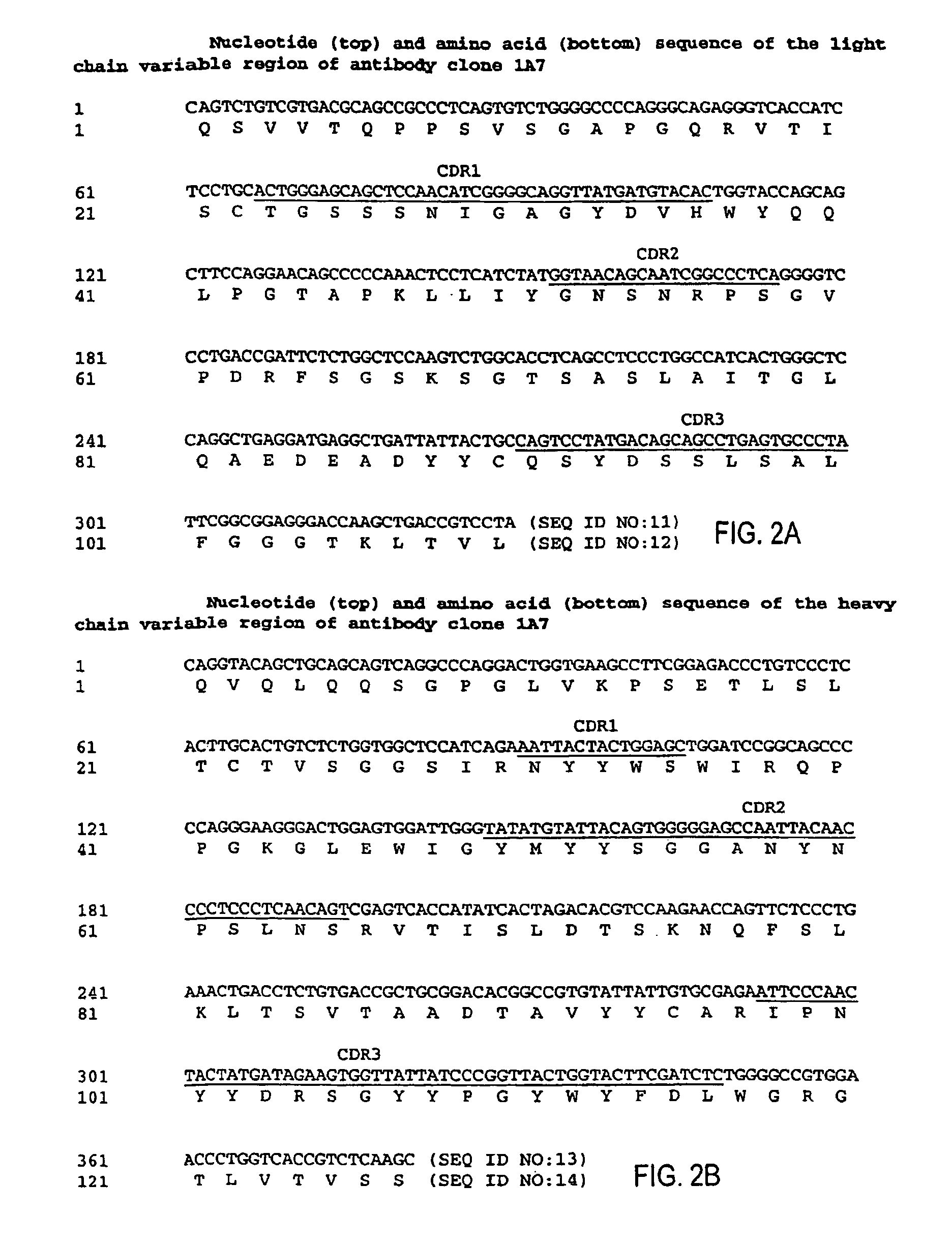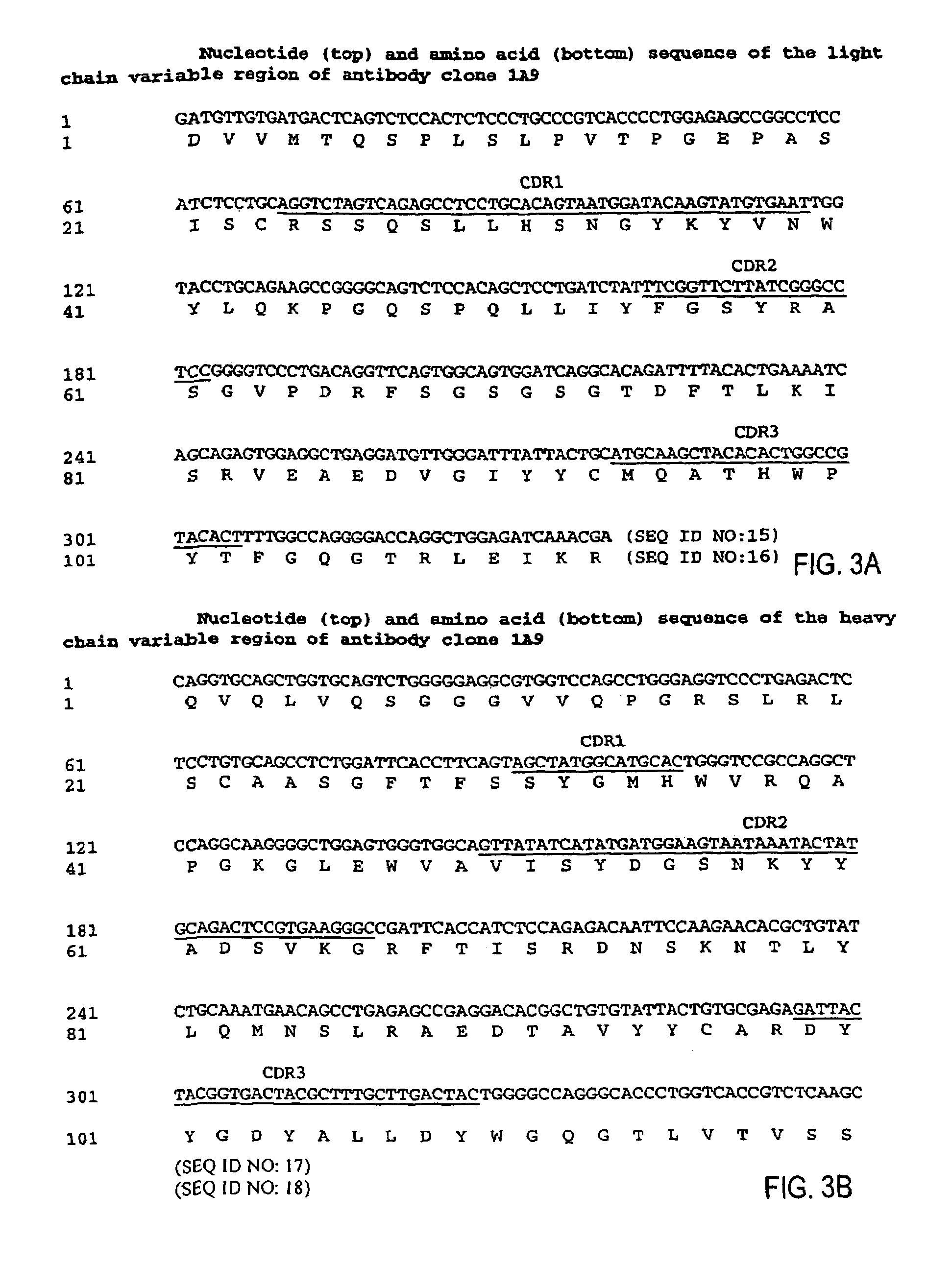MHC-peptide complex binding ligands
a technology of mhc-peptide and complex, which is applied in the field of tumor immunology, can solve the problems of inability of the patient's immune system to elicit an effective immune response against the tumor, inability to detect, count, and study the presentation of antigens, etc., and achieve the effects of reducing tumor size, reducing the appearance of new lesions, and reducing tumor siz
- Summary
- Abstract
- Description
- Claims
- Application Information
AI Technical Summary
Benefits of technology
Problems solved by technology
Method used
Image
Examples
example 1
Methods for Selection and Screening
[0428]1.1 Production of Biotinylated scMHC / Peptide Complexes
[0429]scMHC / peptide complexes were produced by in vitro refolding of inclusion bodies produced in E. coli as described (Denkberg and Reiter (2000) Eur. J Immunol. 30:3522-32). Briefly, a single chain β2 microglobulin-HLA / A2 (scMHC) construct, in which the β2m and HLA-A2 genes are connected to each other by a flexible peptide linker, was designed to contain the BirA recognition sequence for site-specific biotinylation at the C-terminus (scMHC-BirA). This construct is expressed in E. coli and upon induction with IPTG, intracellular inclusion bodies that contain large amounts of the recombinant protein accumulate. Inclusion bodies are purified, reduced and subsequently refolded in a redox-shuffling buffer system (0.1M Tris, 0.5M Arginine, 0.09 mM Oxidized Glutathione, pH 8.0) in the presence of a 5-10 molar excess of the antigenic peptides. Correctly folded MHC / peptide complexes were isolated...
example 2
GP100-HLA-A2 Antibodies
[0443]Here, for the first time, we have isolated a panel of high affinity human recombinant Fab antibodies endowed with the antigen-specific, MHC-restricted specificity of T cells. These antibodies recognize three common HLA-A2-restricted epitopes of the human melanoma differentiation antigen gp100. HLA-A2 is the most frequent human MHC allele that displays many cancer-associated peptides. The antibodies were isolated from a large non-immune repertoire of phage antibody library selected on recombinant-engineered single-chain MHC-peptide complexes displaying a distinct gp100-derived epitope.
[0444]We show that this panel of antibodies recognizes HLA-A2 molecules only when displaying the specific peptide against which they were selected; they do not bind HLA-A2 molecules complexed with other gp100-derived epitopes or with other HLA-A2-restricted control peptides. Hence, they exhibit a TCR-like restriction. Moreover, these antibodies have been used to directly vis...
example 3
Telomerase-HLA-A2 Antibodies
[0476]The recent characterization of MHC-displayed tumor-associated antigens that recognize effector cells of the immune system has created new perspectives for cancer therapy. Antibodies that recognize these tumor associated MHC-peptide complexes with the same specificity as the T-cell antigen receptor will therefore be valuable tools for immunotherapy as well as for the studying antigen presentation in human cancers. Most tumor-associated antigens are expressed in only one or a few tumor types; however, recently specific T-cell epitopes derived from the telomerase catalytic subunit (hTERT) that are widely expressed in many cancers were identified and shown to be recognized by CTLs derived from cancer patients. We selected a large non-immune repertoire of phage Fab antibodies on recombinant human class I HLA-A2 complexes displaying two distinct antigenic T-cell epitopes derived from hTERT. We isolated a surprisingly large panel of high affinity human rec...
PUM
| Property | Measurement | Unit |
|---|---|---|
| dry weight | aaaaa | aaaaa |
| dry weight | aaaaa | aaaaa |
| dry weight | aaaaa | aaaaa |
Abstract
Description
Claims
Application Information
 Login to View More
Login to View More - R&D
- Intellectual Property
- Life Sciences
- Materials
- Tech Scout
- Unparalleled Data Quality
- Higher Quality Content
- 60% Fewer Hallucinations
Browse by: Latest US Patents, China's latest patents, Technical Efficacy Thesaurus, Application Domain, Technology Topic, Popular Technical Reports.
© 2025 PatSnap. All rights reserved.Legal|Privacy policy|Modern Slavery Act Transparency Statement|Sitemap|About US| Contact US: help@patsnap.com



